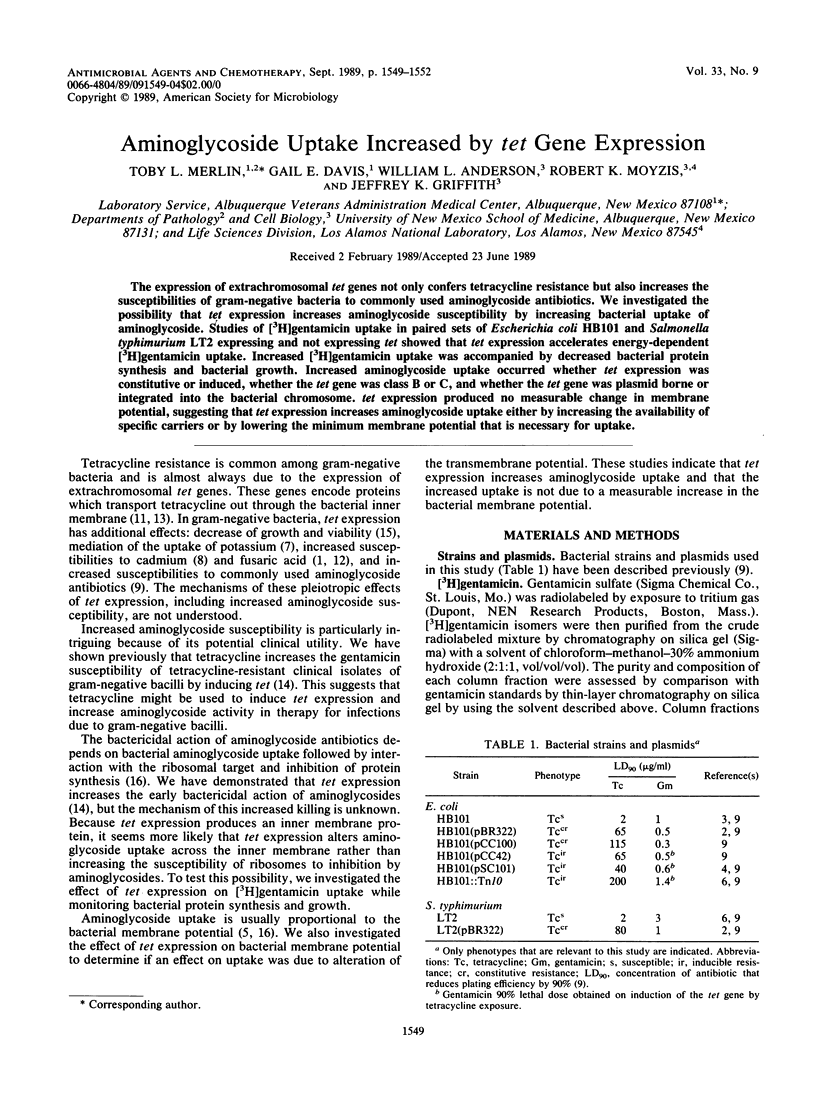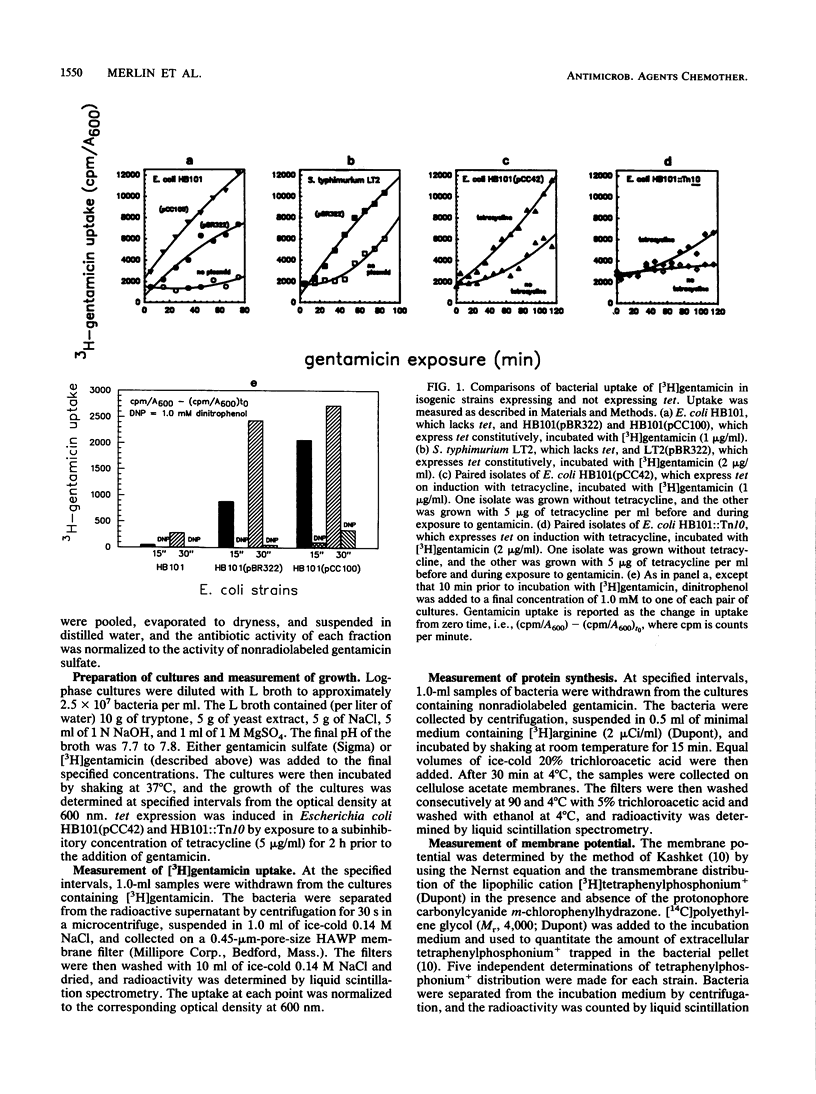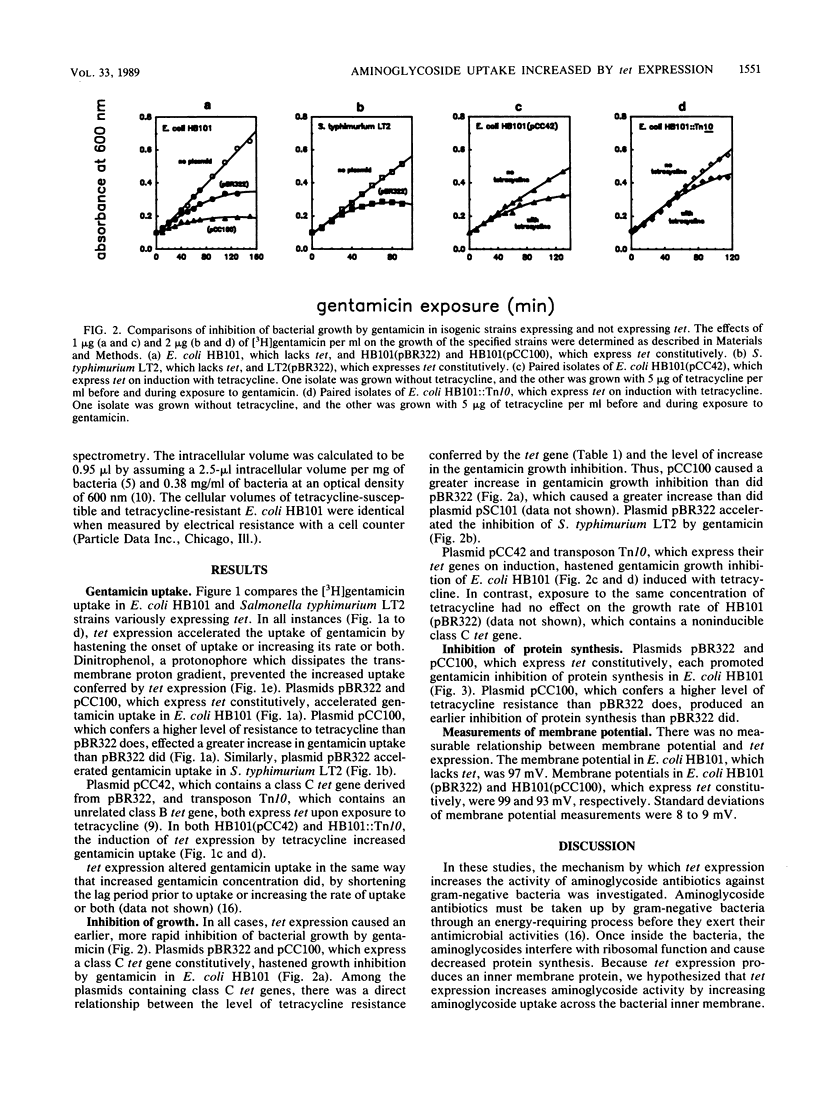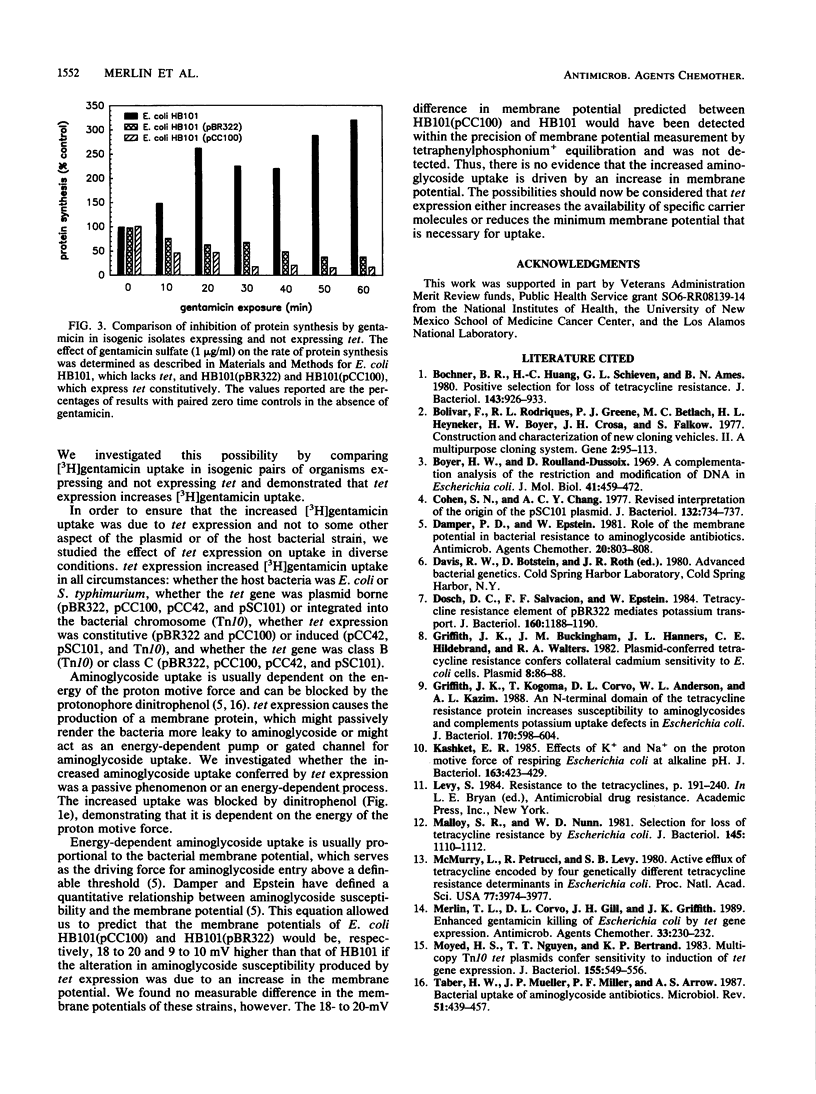Abstract
The expression of extrachromosomal tet genes not only confers tetracycline resistance but also increases the susceptibilities of gram-negative bacteria to commonly used aminoglycoside antibiotics. We investigated the possibility that tet expression increases aminoglycoside susceptibility by increasing bacterial uptake of aminoglycoside. Studies of [3H]gentamicin uptake in paired sets of Escherichia coli HB101 and Salmonella typhimurium LT2 expressing and not expressing tet showed that tet expression accelerates energy-dependent [3H]gentamicin uptake. Increased [3H]gentamicin uptake was accompanied by decreased bacterial protein synthesis and bacterial growth. Increased aminoglycoside uptake occurred whether tet expression was constitutive or induced, whether the tet gene was class B or C, and whether the tet gene was plasmid borne or integrated into the bacterial chromosome. tet expression produced no measurable change in membrane potential, suggesting that tet expression increases aminoglycoside uptake either by increasing the availability of specific carriers or by lowering the minimum membrane potential that is necessary for uptake.
Full text
PDF



Selected References
These references are in PubMed. This may not be the complete list of references from this article.
- Bochner B. R., Huang H. C., Schieven G. L., Ames B. N. Positive selection for loss of tetracycline resistance. J Bacteriol. 1980 Aug;143(2):926–933. doi: 10.1128/jb.143.2.926-933.1980. [DOI] [PMC free article] [PubMed] [Google Scholar]
- Bolivar F., Rodriguez R. L., Greene P. J., Betlach M. C., Heyneker H. L., Boyer H. W., Crosa J. H., Falkow S. Construction and characterization of new cloning vehicles. II. A multipurpose cloning system. Gene. 1977;2(2):95–113. [PubMed] [Google Scholar]
- Boyer H. W., Roulland-Dussoix D. A complementation analysis of the restriction and modification of DNA in Escherichia coli. J Mol Biol. 1969 May 14;41(3):459–472. doi: 10.1016/0022-2836(69)90288-5. [DOI] [PubMed] [Google Scholar]
- Cohen S. N., Chang A. C. Revised interpretation of the origin of the pSC101 plasmid. J Bacteriol. 1977 Nov;132(2):734–737. doi: 10.1128/jb.132.2.734-737.1977. [DOI] [PMC free article] [PubMed] [Google Scholar]
- Damper P. D., Epstein W. Role of the membrane potential in bacterial resistance to aminoglycoside antibiotics. Antimicrob Agents Chemother. 1981 Dec;20(6):803–808. doi: 10.1128/aac.20.6.803. [DOI] [PMC free article] [PubMed] [Google Scholar]
- Dosch D. C., Salvacion F. F., Epstein W. Tetracycline resistance element of pBR322 mediates potassium transport. J Bacteriol. 1984 Dec;160(3):1188–1190. doi: 10.1128/jb.160.3.1188-1190.1984. [DOI] [PMC free article] [PubMed] [Google Scholar]
- Griffith J. K., Buckingham J. M., Hanners J. L., Hildebrand C. E., Walters R. A. Plasmid-conferred tetracycline resistance confers collateral cadmium sensitivity of E. coli cells. Plasmid. 1982 Jul;8(1):86–88. doi: 10.1016/0147-619x(82)90044-0. [DOI] [PubMed] [Google Scholar]
- Kashket E. R. Effects of K+ and Na+ on the proton motive force of respiring Escherichia coli at alkaline pH. J Bacteriol. 1985 Aug;163(2):423–429. doi: 10.1128/jb.163.2.423-429.1985. [DOI] [PMC free article] [PubMed] [Google Scholar]
- Maloy S. R., Nunn W. D. Selection for loss of tetracycline resistance by Escherichia coli. J Bacteriol. 1981 Feb;145(2):1110–1111. doi: 10.1128/jb.145.2.1110-1111.1981. [DOI] [PMC free article] [PubMed] [Google Scholar]
- McMurry L., Petrucci R. E., Jr, Levy S. B. Active efflux of tetracycline encoded by four genetically different tetracycline resistance determinants in Escherichia coli. Proc Natl Acad Sci U S A. 1980 Jul;77(7):3974–3977. doi: 10.1073/pnas.77.7.3974. [DOI] [PMC free article] [PubMed] [Google Scholar]
- Merlin T. L., Corvo D. L., Gill J. H., Griffith J. K. Enhanced gentamicin killing of Escherichia coli by tet gene expression. Antimicrob Agents Chemother. 1989 Feb;33(2):230–232. doi: 10.1128/aac.33.2.230. [DOI] [PMC free article] [PubMed] [Google Scholar]
- Moyed H. S., Nguyen T. T., Bertrand K. P. Multicopy Tn10 tet plasmids confer sensitivity to induction of tet gene expression. J Bacteriol. 1983 Aug;155(2):549–556. doi: 10.1128/jb.155.2.549-556.1983. [DOI] [PMC free article] [PubMed] [Google Scholar]
- Taber H. W., Mueller J. P., Miller P. F., Arrow A. S. Bacterial uptake of aminoglycoside antibiotics. Microbiol Rev. 1987 Dec;51(4):439–457. doi: 10.1128/mr.51.4.439-457.1987. [DOI] [PMC free article] [PubMed] [Google Scholar]


